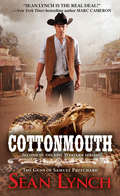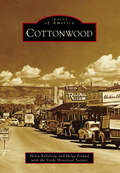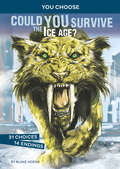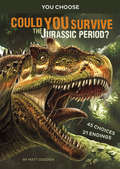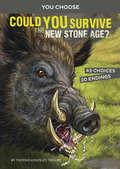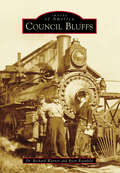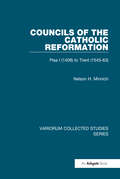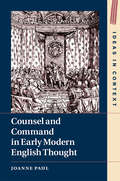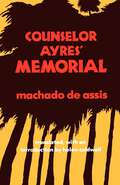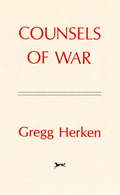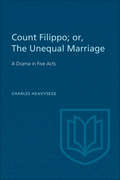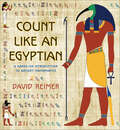- Table View
- List View
Cottonmouth (The Guns of Samuel Pritchard #2)
by Sean LynchA legendary gunfighter can never outrun the ghosts of his past. But he can outshoot them. Acclaimed author Sean Lynch’s epic saga of Samuel Pritchard continues—with a venegance . . . CALLING ALL KILLERS 1874. After losing his innocence in the Civil War and risking his life as a Texas Ranger, Samuel Pritchard has finally settled into a peaceful life in his hometown of Atherton, Missouri. As marshall, he hopes to put his bloody past behind him. To see his sister marry his lifelong friend. To find a wife and raise a family. For the first time in his life, Pritchard isn’t gunning for anyone—and no one is gunning for him. Or so he thinks. Strangers have arrived in Atherton. Hard-eyed men with guns. Someone has placed a bounty on Pritchard’s head: $10,000 in gold, deposited anonymously in a Wells Fargo bank, payable to anyone who puts the legendary pistolero in a pine box. . . . This is the story of Samuel Pritchard. A small-town sheriff with a larger-than-life reputation, lightning-fast guns, and a long list of enemies who’d love to see him dead. . . . “A riveting thriller that bristles with hard-boiled authenticity.”—Bestselling author Mark Greaney on Thy Partner’s Wife “Sean Lynch spins a tale that is fast, fun and realistic.”—Bestselling author James O. Born on Like Hell
Cottonwood
by Helga Freund Verde Historical Society Helen KillebrewIn the last quarter of the 19th century, a circle of 16 tall Cottonwood trees stood in the wash that extended to the Verde River just north of where the old jail building now stands. Cattlemen and ranchers from Oak Creek and the mountains made their overnight stops under these trees and the location became known as "The Cottonwoods." The lush riparian area attracted hardy settlers, and Fort Verde's military camp and the copper mines of Jerome provided a ready market for agricultural goods. Thus began the town that was soon to become the commercial hub for the Verde Valley. Today the incorporated city of Cottonwood serves an area population of over 55,000 and boasts a diverse economy based on health care, education, tourism, and the service and retail industries. With its moderate climate, beautiful setting, and small-town charm, combined with the amenities of a larger city, Cottonwood continues to attract steady growth and tourism.
Cottonwood
by Scott PhillipsFrom the author of New York Times Notable book The Ice Harvest, a cult classic of Western noir set in a 19th century Kansas frontier town rocked by a series of brutal murders Introducing photographer and saloon owner Bill Ogden. Perfect for fans of Deadwood and JustifiedIn 1872, Cottonwood, Kansas, is a one-horse speck on the map; a community of run-down farms, dusty roads, and two-bit crooks. Self-educated saloon owner and photographer Bill Ogden looks on his adopted town with an eye to making a profit or getting out. His brains and ambition bring him to the attention of one Marc Leval, a wealthy Chicago developer with big plans for the small town. The advent of the railroad and rumors of a cattle trail turn Cottonwood into a wild and wooly boomtown—and with Leval as a partner, Ogden dreams of bringing civilization to the prairie.But civilizing the Great Plains was never that simple. While many in Cottonwood distrust Leval&’s motives, and mob violence threatens to derail the town&’s dreams of greatness, Ogden finds himself dangerously obsessed with Leval&’s stunningly beautiful wife. Meanwhile, plying its sinister trade unnoticed, an apparently ordinary local farm family quietly butchers traveling salesmen, weary travelers, and other unsuspecting wanderers.In his own inimitable brand of narrative wizardry, Scott Phillips traces the metamorphosis of a frontier town that becomes a lightning rod for sin, corruption, and murder. He also brings to life actual crimes that befell Kansas in the 1870s and 1880s, carried out by a strange clan who popularly became known as the Bloody Benders. Brilliantly written, maliciously fun, and full of many surprises, Cottonwood is historical fiction at its finest.
Cotuit and Santuit
by James W. Gould Jessica Rapp GrassettiCotuit, a name derived from a Native American word meaning "place of the council," has a rich history that predates Colonial times and includes continuous Native American habitation. Paired with Santuit on the south shore of Cape Cod and warmed by the Gulf Stream, Cotuit has long been a favorite summer resort and was home to Cape Cod's first hotel. Its greatest attraction has always been the sweet Cotuit oysters, which are shipped to the best shellfish bars in the country.This quiet and unspoiled New England village, once a refuge for pirates, deepwater sailors, and coastal traders, hold secrets that are told only in Cotuit and Santuit. They are home to such people as Henry Adams, whose courtship took place here; the Cape Cod Commandos; a pioneer whistle-blower fighting against environmental pollution; and the witch Hannah Screecham, who guarded Captain Kidd's treasure. Cotuit and Santuit reveals the adventures of the Holy Ghost Festival, the baby brought home from the Pacific whaling grounds in a cask of rum, and the trek over the Arctic Ocean across thirty miles of ice.
Couch City: Socrates against Simonides
by Harry BergerCrowning six decades of literary, rhetorical, and historical scholarship, Harry Berger, Jr., offers readers another trenchant reading. Berger subverts the usual interpretations of Plato’s kalos kagathos, showing Socrates to be trapped in a double ventriloquism, tethered to his interlocutors’ speech acts even as they are tethered to his. Plato’s Republic and Protagoras both reserve a small but significant place for a poet who differs from Homer and Hesiod: the lyric poet Simonides of Ceos. In the Protagoras, Socrates takes apart a poem attributed to Simonides and uses this to finish off the famous and supposedly dangerous sophist, Protagoras. Couch City is a close reading of the comic procedures Socrates deploys against Protagoras as he reduces him to silence. But it also shows that Socrates takes the danger posed by Protagoras and his fellow sophists seriously. Even if they are represented as buffoons, sophists are among the charismatic authority figures—poets, rhapsodes, seers, orators, and lawgivers—who promote views harmful to Athenian democracy. Socrates uses Simonides’s poem to show how sophists not only practice misinterpretation but are unable to defend against it. Berger ports his roots as a pioneering literary theorist into this rhetorical discussion, balancing ideas such as speech-act theory with hard-nosed philology. The result is a provocative and counterintuitive reassessment of Plato’s engagement with democracy.
Cougar Tracks
by Paul LedererTo avenge his beloved, an old tracker comes out of retirement After years fighting the Apache for the United States Army, Carroll Cougar builds a cabin in the heart of the Texas prairie. When a local rancher tries to take it away from him, Cougar takes a stand, waiting in the trees when the rancher and his son come to attack. With a few shots from his .56 Spencer, he defends his property, believing that peace is his at last. But another disturbance soon follows, from a completely unexpected source. An old army buddy reaches Cougar with a letter from President Grant begging the tracker to join up for one last mission. It isn&’t the president&’s name that convinces him—it&’s the name of the target: Solon Reineke, the gunman who murdered the only woman Cougar ever loved. For the sake of vengeance, he will pick up the trail one last time, even if it means never knowing peace again.
Cougar's Conquest
by Linda O. JohnstonGwynn Macka hasn't seen Brett Sorrellson in over a year, not since their relationship had ended so abruptly. Not since the brilliant, sexy man she fell for learned her secret and she'd been forced to flee.Now Brett is back with an offer to join a covert military unit of shapeshifters, and the spark of their attraction is instantly reignited. Neither can resist sharing one last night of passion, but as a cougar shifter, Gwynn had been taught only to trust her own kind. Can she truly trust Brett with her secret...and with her heart?
Could You Survive the Cretaceous Period?: An Interactive Prehistoric Adventure (You Choose: Prehistoric Survival)
by Eric BraunYou've just been transported back in time. Exotic plants tower above your head, while giant rat-like creatures scuttle around you. What concerns you most, however, are the meat-eating dinosaurs that are the size of a house! Do you think you have what it takes to survive the Cretaceous Period? Turn the pages to find out!
Could You Survive the Ice Age?: An Interactive Prehistoric Adventure (You Choose: Prehistoric Survival)
by Blake HoenaYou've just been sent many thousands of years back in time. The climate is cold and the landscape is strange. The people you encounter look quite different than modern-day humans. But what worries you most are the fierce saber-toothed cats and the giant wooly mammoths that roam the land. Do you think you have what it takes to survive the last ice age? Turn the pages to find out!
Could You Survive the Jurassic Period?: An Interactive Prehistoric Adventure (You Choose: Prehistoric Survival)
by Matt DoedenYou've just been sucked back in time millions of years! Grasses sway higher than your head. Huge insects swarm the skies and fearsome dinosaurs rule the landscape. Do you think have what it takes to survive in the Jurassic Period? Turn the pages to find out!
Could You Survive the New Stone Age?: An Interactive Prehistoric Adventure (You Choose: Prehistoric Survival)
by Thomas Kingsley TroupeYou've suddenly time traveled thousands of years into the past. The world around you looks wild and unfamiliar. The humans you encounter can't understand a word you say. Now they're running at you carrying stone tools! Do you have what it takes to survive in the Stone Age? Turn the pages to find out!
Could the Versailles System have Worked?
by Howard ElcockThis book explores the significance of the post-First World War peace settlement negotiated at Versailles in 1919. Versailles has always been a controversial subject and it has long been contended that the Treaty imposed unnecessarily severe conditions upon the defeated nations, particularly Germany, and in large part can be held responsible for the outbreak of war in 1939. This book considers the critical question as to whether the Treaty of Versailles established a new international settlement that could produce a peaceful and prosperous Europe, something that many have alleged was impossible. In an exhaustive analysis of the events that followed the Paris Peace Conference, Howard Elcock argues that the Versailles Treaty created a more stable diplomatic framework than has commonly been recognised, and challenges the traditional understanding that the delegates at Versailles can be held responsible for the failure to secure long-term peace in Europe.
Council Bluffs
by Dr Richard Warner Ryan RoenfeldAll traces of Captain Caldwell's Potawatomi settlement and the Mormon safe haven of Kanesville were gone from the Indian Creek hollow by 1900, when Council Bluffs already seemed a 20th-century city of bright lights, steam, and smokestacks. The old western trails and steamboats disappeared as the city on the east bank of the Missouri River opposite Omaha became a major American railroad center and the industrial and commercial hub of southwest Iowa. Vineyards and orchards surrounded a growing city, with more acres under glass for greenhouses than anywhere else in the country and a daily stop for the Zephyr, Hiawatha, Rocket, Challenger, and other streamlined passenger trains. The West End was filled in, and new neighborhoods like Danetown and Little Vienna grew with new immigrants. All of the people of Council Bluffs faced fires, floods, and tornados as the "Blue Denim City," where America's mail was sorted survived economic upheaval, urban renewal, and eventual resurgence in the last decade of the century.
Council Democracy: Towards a Democratic Socialist Politics (Routledge Advances in Democratic Theory)
by James MuldoonThe return to public assemblies and direct democratic methods in the wave of the global "squares movements" since 2011 has rejuvenated interest in forms of council organisation and action. The European council movements, which developed in the immediate post-First World War era, were the most impressive of a number of attempts to develop workers’ councils throughout the twentieth century. However, in spite of the recent challenges to liberal democracy, the question of council democracy has so far been neglected within democratic theory. This book seeks to interrogate contemporary democratic institutions from the perspective of the resources that can be drawn from a revival and re-evaluation of the forgotten ideal of council democracy. This collection brings together democratic theorists, socialists and labour historians on the question of the relevance of council democracy for contemporary democratic practices. Historical reflection on the councils opens our political imagination to an expanded scope of the possibilities for political transformation by drawing from debates and events at an important historical juncture before the dominance of current forms of liberal democracy. It offers a critical perspective on the limits of current democratic regimes for enabling widespread political participation and holding elites accountable. This timely read provides students and scholars with innovative analyses of the councils on the 100th anniversary of their development. It offers new analytic frameworks for conceptualising the relationship between politics and the economy and contributes to emerging debates within political theory on workplace, economic and council democracy.
Council: Helga Finnsdottir Book II
by Snorri Kristjansson'For Vikings done right, come to Snorri Kristjansson' Mark Lawrence, author of Red SisterAfter five years on the road, Helga has finally settled near King Eirik's court in Uppsala, where she's well-regarded as a healer. She's even in a relationship, of sorts.But life is about to get a bit more exciting, for King Eirik has summoned all those who owe him fealty to the King's Council and tempers are already flaring. The body of an unknown boy is found near the river, but with delegations from all over the country arriving and rumours of an imminent attack, there are more important things to attend to than the death of a nobody . . .Only Helga suspects murder, until a second body makes it clear that someone is intent on breaking up the King's Council - and that a traitor walks among them . . .
Council: Helga Finnsdottir Book II (The Helga Finnsdottir Mysteries #2)
by Snorri Kristjansson'For Vikings done right, come to Snorri Kristjansson' Mark Lawrence, author of Red SisterAfter five years on the road, Helga has finally settled near King Eirik's court in Uppsala, where she's well-regarded as a healer. She's even in a relationship, of sorts.But life is about to get a bit more exciting, for King Eirik has summoned all those who owe him fealty to the King's Council and tempers are already flaring. The body of an unknown boy is found near the river, but with delegations from all over the country arriving and rumours of an imminent attack, there are more important things to attend to than the death of a nobody . . .Only Helga suspects murder, until a second body makes it clear that someone is intent on breaking up the King's Council - and that a traitor walks among them . . .
Councils of the Catholic Reformation: Pisa I (1409) to Trent (1545-63) (Variorum Collected Studies)
by Nelson H. MinnichThis new collection by Nelson Minnich deals with the general councils of the Catholic Reformation in the late medieval and early modern periods. The volume opens with overviews of the various editions of and current scholarship on these general councils. Three studies then give special attention to the role of theologians in these councils: their changing legal status (consultative or deliberative voting rights) and their individual roles and those of the various theological schools in drafting the decrees. Another article examines the legal status of theologians accused of heresy and schism. Two examine the contest between the councils of Pisa-Milan-Asti-Lyon and Lateran V for legitimacy, studying in particular the contrasting image of Julius II (suspended for contumacy by Pisa but the strong leader of Lateran V) and the role ceremonies played in securing legitimacy. Last, there are three studies devoted to the Council of Trent: the status of the Protestants who came to the council, its debates on the priesthood of all believers, and the influence of Lateran V on its procedures, debates, and decrees.
Counsel and Command in Early Modern English Thought (Ideas in Context #125)
by Joanne PaulWhile it has often been recognised that counsel formed an essential part of the political discourse in early modern England, the precise role that it occupied in the development of political thinking has remained obscure. This comprehensive and rigorous study of early modern English political counsel establishes the importance of the relationship between political counsel and the discourse of sovereignty. Tracing the changes and evolution of writings on political counsel during the 'monarchy of counsel', from the end of the Wars of the Roses to the end of the English Civil War, Joanne Paul examines English thought in its domestic and transnational context, providing an original account of the relationship between counsel and emerging conceptions of sovereignty. Formed at the conjunction of the history of political thought and English political history, this book grounds textual analysis within the context of court politics, intellectual and patronage networks, and diplomacy.
Counseling Adults in Transition: Linking Schlossberg's Theory with Practice in a Diverse World (Fourth Edition)
by Mary Louise Anderson Jane Goodman Nancy K. SchlossbergThe only textbook explicitly designed to address counseling with adults who are coping with individual, relationship, and work transitions, this volume integrates the basic tenets of adult development with therapeutic practice. It is based on Schlossberg's theory of transitions, a new process and content model that offers effective techniques for . . . . . .
Counselor Ayres' Memorial
by Joaquim M. Machado de Assis"A small masterwork, freshly translated , by one of the great novelists of the 19th century. A retired Brazilian diplomat (Ayres) recounts the love affair of a young widow who would rather be faithful to her dead Romeo. How she rejoins the world of the living, rekindling Ayres' spirit as well, is told with muted allusions to Brazil's plantation life and its emancipation of the slaves."--Chicago Tribune "This novel first appeared in 1908 , the year of Machado de Assi s' death . . It is a mild story, mildly told with a muted form of irony . . it is without self-pity, an elegiac book . . . unmistakably the work of a masterful writer."--Kirkus Reviews "Packed with wit, with compassion, with valiant self-knowledge. It is an experience I urge you to undertake."--Cleveland Plain Dealer "A novel as ironic as any of Machado's earlier fiction, but with a new sense of ripeness and tender regard for those whom life tries and tests. It is a last fitting monument to the art of Machado de Assis."--Nation
Counselor: A Life at the Edge of History
by Theodore C. SorensonIn his memoir Counselor, Theodore C. Sorensen recounts advising John F. Kennedy through the most dramatic moments in American history.JFK’s closest guide, Sorensen begins his story in January 1953, when he and the freshman senator from Massachusetts began their extraordinary professional and personal relationship. Rising from legislative assistant to speechwriter and advisor, the young lawyer from Nebraska worked closely with JFK on his most important speeches, as well as his book Profiles in Courage. Sorensen encouraged the junior senator's political ambitions—from a failed bid for the vice presidential nomination in 1956 to the successful presidential campaign in 1960, after which he was named Special Counsel to the President.Sorensen describes in thrilling detail his experience advising JFK during some of the most crucial days of his presidency, from the decision to go to the moon to the Cuban Missile Crisis, when JFK requested that the thirty-four-year-old Sorensen draft the key letter to Khrushchev at the most critical point of the world's first nuclear confrontation. After Kennedy was assassinated, Sorensen stayed with President Johnson for a few months before leaving to write a biography of JFK. In 1968 he returned to Washington to help run Robert Kennedy's presidential campaign. Through it all, Sorensen never lost sight of the ideals that brought him to Washington and to the White House, working tirelessly to promote and defend free, peaceful societies.“This book is instantly essential for any student of the period. It fills gaps in the historical record; it vividly conveys life inside the administration; and it generously dishes anecdotes.” —Washington Post
Counsels of War
by Gregg F. HerkenSince the first atomic bomb was exploded in 1945, a close community of civilian experts, including scientists, academics, and think-tank intellectuals, has advised the American government on the prospects of nuclear war. Based on interviews with these experts, as well as hundreds of pages of recently declassified documents, Counsels of War is the first book to trace in detail the deliberations and shifting recommendations of the experts on the bomb from Hiroshima to "Star Wars."Gregg Herken writes about the people whose profession it has been to think about the unthinkable--Robert McNamara, Paul Nitze, Herman Kahn, Bernard Brodie--including their intense rivalries, personal animosities, and often contentious relationship with the professional military. He reveals how the influence of the scientist and strategist has extended well beyond the laboratory and the classroom--in the proposal of Kennedy's advisers for a nuclear "demonstration" and even a "clever first-strike" against the Russians, for example. Counsels of War also shatters certain popular assumptions about U.S. nuclear policy. As Herken points out, while American doctrine stresses "retaliation," U.S. strategists have always planned to "pre-empt" a Soviet attack.Herken shows that the lines in the current nuclear debate were actually drawn at the dawn of the atomic age, and that the experts' technically abstruse arguments have only served to hide from the public the fundamental, deeply held--and quite subjective--differences at the heart of the debate. Since Hiroshima, there has been a growing awareness of the peril created by nuclear weapons, yet the crucial questions that were never adequately addressed in 1945 unanswered today. Given the inability of the experts to confront the essential dilemma of the nuclear age, Counsels of War calls for a new nuclear debate, one focused on American rather than Soviet intentions and that seeks an answer to the fundamental, yet still unresolved question: What are these weapons for?
Count Belisarius (Modern Classics Ser. #Vol. 65)
by Robert GravesThis &“vigorous tale&” by the acclaimed author of I, Claudius captures the sixth century fall of the Byzantine Empire as seen through the eyes of a servant (Kirkus Reviews). Threatened by invaders on all sides, the Eastern Roman Empire of the sixth century fought to maintain its borders. Leading its defense was the Byzantine general Belisarius, a man who earned the grudging respect of his enemies, and who rose to become Emperor Justinian&’s greatest military leader. Loosely based on Procopius&’s History of the Justinian Wars and Secret History, this novel tells the Belisarius&’s story through the eyes of Eugenius, a eunuch and servant to the general&’s wife. It presents a compelling portrait of a man bound by a strict code of honor and unrelenting loyalty to an emperor who is intelligent but flawed, and whose decisions bring him to a tragic end. Eminent historical novelist and classicist Robert Graves presents a vivid account of a time in history both dissolute and violent, and demonstrates one again his mastery of this historical period. &“A brilliant piece of scholarship.&” —Kirkus Reviews &“The scope of the book is massive—encompassing religious controversy and cultural developments as well as military history—yet, throughout, Graves succeeds in blending historical details with the development of his main characters.&” —Historical Novel Society
Count Filippo; or The Unequal Marriage: A Drama in Five Acts
by Douglas Lochhead Charles HeavysegeA five-act tragedy in blank verse. The play is founded upon the old problem of an unnatural and ill-omened union between youth and age.
Count Like an Egyptian: A Hands-on Introduction to Ancient Mathematics
by David ReimerA lively collection of fun and challenging problems in ancient Egyptian mathThe mathematics of ancient Egypt was fundamentally different from our math today. Contrary to what people might think, it wasn't a primitive forerunner of modern mathematics. In fact, it can’t be understood using our current computational methods. Count Like an Egyptian provides a fun, hands-on introduction to the intuitive and often-surprising art of ancient Egyptian math. David Reimer guides you step-by-step through addition, subtraction, multiplication, and more. He even shows you how fractions and decimals may have been calculated—they technically didn’t exist in the land of the pharaohs. You’ll be counting like an Egyptian in no time, and along the way you’ll learn firsthand how mathematics is an expression of the culture that uses it, and why there’s more to math than rote memorization and bewildering abstraction.Reimer takes you on a lively and entertaining tour of the ancient Egyptian world, providing rich historical details and amusing anecdotes as he presents a host of mathematical problems drawn from different eras of the Egyptian past. Each of these problems is like a tantalizing puzzle, often with a beautiful and elegant solution. As you solve them, you’ll be immersed in many facets of Egyptian life, from hieroglyphs and pyramid building to agriculture, religion, and even bread baking and beer brewing.Fully illustrated in color throughout, Count Like an Egyptian also teaches you some Babylonian computation—the precursor to our modern system—and compares ancient Egyptian mathematics to today’s math, letting you decide for yourself which is better.
